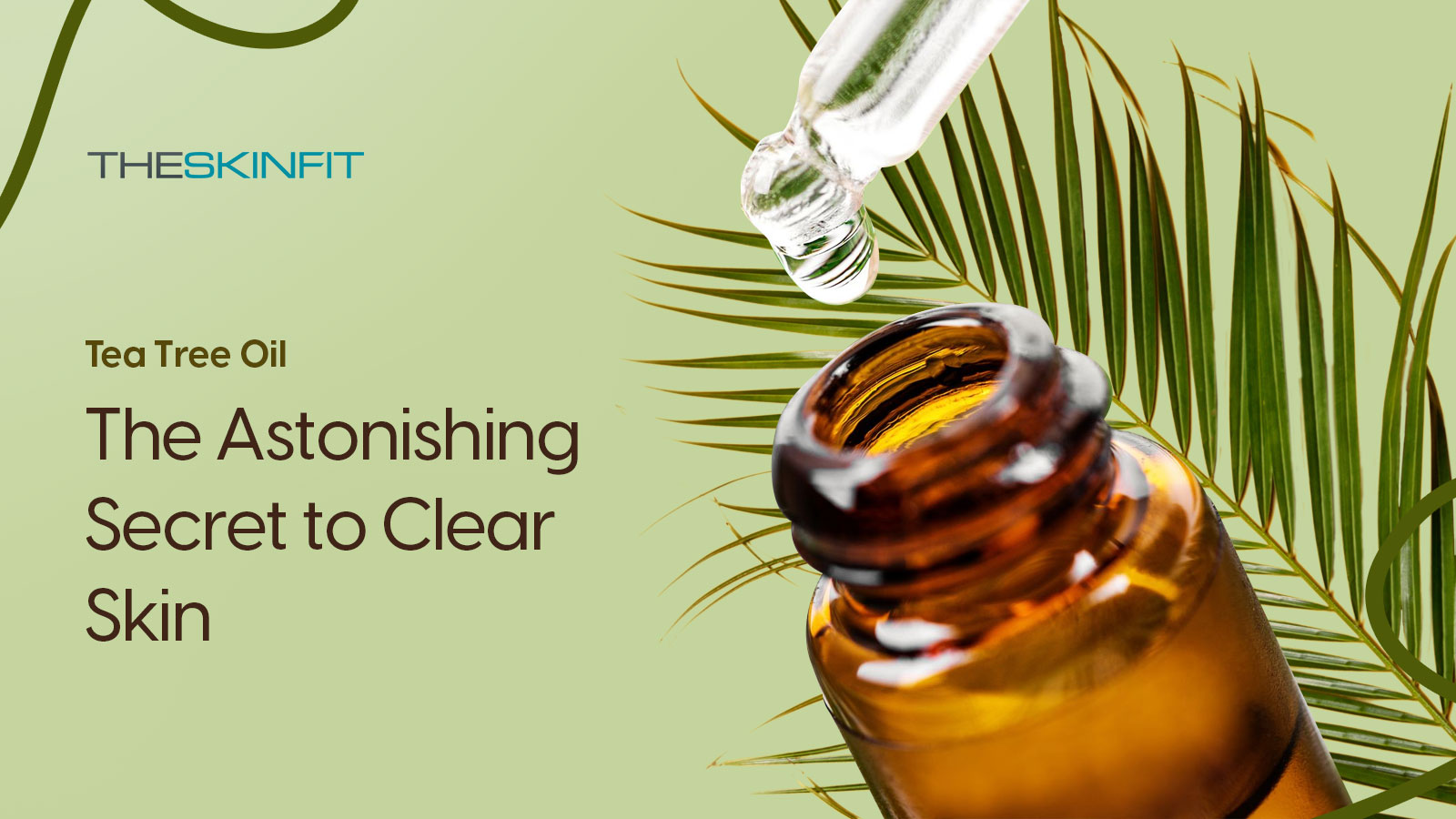It's okay, and we've got you covered with info on the safest and most effective all-natural skincare components. This article will talk about tea tree oil and how it affects the skin, including both its pros and cons.
What About Tea Tree Oil?
Tea tree oil's antiseptic and wound-healing characteristics, called Melaleuca, make it one of the best essential oils for fighting germs.
Tea tree oil is made from an Australian shrub called Melaleuca alternifolia. It is a volatile essential oil. Almost all 232 species of plants that make up the Melaleuca genus are found only in Australia.
What are the uses of Tea Tree Oil?
The tea tree was called by eighteenth-century sailors who produced nutmeg-scented tea from its leaves. Tea tree oil has chemicals that may stop germs, fungi, and pests from growing and relieve allergy symptoms by making the skin less puffy.
Acne, toenail fungus, and athlete's foot are just some of the many skin conditions that tea tree oil can treat. It is also said to help with dandruff, lice, and bad breath, but science doesn't back up these claims.
It can also be used on your skin, like:
Tea Tree Oil for Acne
Tea tree oil's anti-inflammatory qualities help soothe irritated skin. It relieves itching and heals infections. Tea tree oil heals acne scars naturally. It helps hypertrophic scars heal and fade.
How to Apply Tea Tree Oil on Acne Face
- Use two to four drops of tea tree oil with coconut oil on the afflicted spot twice daily.
- Dab diluted tea tree oil on pimples with a cotton ball or pad and dried it.
- Apply moisturizer. Repeat morning and night.
- You shouldn't put tea tree oil on your skin directly.
- Dilute the oil with olive, coconut, or almond oil.
- Add 12 drops of carrier oil to 1–2 drops of tea tree oil.
It fades scars, spots, and imperfections. Tea tree oil reduces acne. It treats dandruff, gingivitis, and other skin disorders. Water dilutes tea tree oil better.
Tea Tree Oil for Hair
Tea tree oil has been used for millennia. It has high-saliva antibacterial, antifungal, and anti-inflammatory properties. It treats dandruff and a flaky scalp.
Tea tree oil may increase hair development by keeping follicles healthy and increasing scalp blood flow. It cleans the scalp well. Tea tree oil cleans hair follicles and prevents dandruff. It controls sebaceous gland oil production, and healthy hair follicles generate hair.
How to apply tea tree oil on hair
For hair regrowth,
- blend a few drops of tea tree oil with any carrier oil (coconut, jojoba, almond).
- Combine and massage the scalp and rinse well.
- The combination should freshen and tingle your scalp.
Tea tree oil blended with olive oil softens, smooths, protects against pollutants, and promotes hair growth.
- Warm olive oil for a few seconds and add 3-5 drops of tea tree oil.
- Use this combination on your scalp and hair at least once a day for three weeks to achieve great results.
Tea Tree Oil for Dandruff
Tea tree oil's antifungal and antibacterial capabilities cure dandruff fungus without drying your scalp. It conditions hair naturally and removes flaking agents.
- Add ten drops of tea tree oil to 8 ounces of shampoo.
- Wash your hair and let the tea tree oil mixture soak for 3-5 minutes.
- The oil will penetrate the hair and treat the scalp.
- Rinse your hair when the oil sets.
Tea Tree Oil for Dry Scalp
Tea tree oil hydrates and nourishes the dry scalp and hair. Clearing pores prevents dryness and irritation.
- Mix a few drops of tea tree oil with jojoba oil for a dry scalp.
- Massage your scalp for 10-15 minutes.
- Rinse well and shampoo your hair.
- Repetition relieves dry scalp issues.
Tea tree oil can serve as a conditioner to treat dry scalp itching.
- After shampooing, mix a few drops of tea tree oil into your conditioner.
- Apply to scalp and hair. Rinse after a few minutes.
Tea Tree Oil for Skin
Terpinen-4-ol is the main ingredient in Tea Tree Oil. It comes from the leaves of Melaleuca alternifolia and has many healing properties for the skin.
Tea tree oil treats wounds, grazes, acne, herpes, dandruff, muscular pains, stress, strains, rheumatic problems, sunburn, and bronchial infections and stimulates the immune system.
Tea tree oil uses for skin.
1- Burners/vaporizers
The vapor from tea tree oil is used to treat colds, sinusitis, bronchitis, and other respiratory illnesses. It also helps the mind heal after a traumatic event.
2. Blended massage oil or bath
Tea tree oil helps all respiratory diseases, arthritis, colds, dermatitis, skin infections, scalp disorders, sinusitis, viral infections, nettle rash, babies' colds and coughs, bronchitis, sweaty feet, and more as a massage oil or bath additive.
3. Cleaning with water
It can cure abscesses, bed sores, acne, boils, lice, dandruff, wounds, and animal or human bites when added to washing water or administered with a cotton bud.
4- Breath freshener
Tea tree oil may be used as a mouthwash for gum infections, oral ulcers, throat infections, and tonsillitis. Garlic eaters claim it lowers garlic breath.
5. Moisturiser
Tea tree oil can be mixed into a cream or lotion and applied to the skin to treat a variety of issues, including swellings, abscesses, acne, bite wounds from animals and humans (although a medical professional should be consulted), dandruff and other scalp disorders, bed sores, diaper rash, and other rashes.
Tea Tree Oil for Face
Tea tree oil is among the most effective treatments for skin conditions like acne. Yet, it has potentially negative consequences if taken improperly. Even if your face isn't compassionate, pure tea tree oil might burn it. It may also trigger a skin rash or breakout. Itchy, dry skin is not a good candidate for tea tree oil. Tea tree oil is excellent for oily, acne-prone, or combination skin.
Tea tree oil should only be used after the following steps.
- Add carrier oil to reduce the concentration.
- Use it selectively, never all over your face.
- Don't mix it with your all-over facial treatment (whether that's a moisturizer, facial oil, serum, mask, or toner)
- Use it once a day at most.
- Do not use it to break, peel, scaly, inflame, or open wounds.
- Be sure to wait until you've steamed your face before using it.
- Take a break from using it after your workout.
- Stop using it if it causes pain, dryness, or redness.
- Use oil instead of water to dilute it.
How to Apply Tea Tree Oil on Face
To use tea tree oil on your face, dilute it with a carrier oil like jojoba or almond oil. This tea tree oil face toner recipe is easy:
- Mix in a tiny spray bottle:
- 1/4 water 1/4 witch hazel
- 10-drop tea tree oil
- 5-drop carrier oil (optional)
- Shake the toner container and spray on a cotton pad.
- Carefully clean your face with the cotton pad, avoiding the eyes.
- Apply toner once or twice a day, depending on your skin type and concerns.
Patch-test new skincare products before putting them on your face. Patch test the effect on your inside arm. Wait 24 hours for redness or inflammation. Avoid the product if it irritates your skin.
Start with a low tea tree oil concentration and gradually increase it as your skin adjusts. Pay attention to your skin's response and modify the concentration of tea tree oil that produces irritation or dryness.
Tea Tree Oil Side Effects
Tea tree is usually considered safe when taken aromatically and physically and seldom causes adverse effects. On the other hand, you can have an allergic response if your skin is very delicate.
Avoid swallowing tea tree oil since it might be harmful. Put it somewhere where kids can't access it.
Tea tree oil may cause allergic reactions in some people. Therefore, it's essential to do a skin patch test beforehand.
The vast majority of individuals may safely use tea tree oil topically. While beneficial, tea tree oil has the potential to cause:
- Unpleasantness to the skin
- Rashes caused by allergies (dermatitis)
- Scratching
- Stinging \Burning
- Erythema
- Dryness
If you suffer from eczema, avoid using tea tree oil.
Conclusion
Certain people are more prone to developing certain skin disorders because of their skin types. Your genetically determined skin tone will eventually show the effects of your environment and lifestyle choices.
Tea tree oil has several uses, but among the most notable is its capacity to heal nail fungus, kill lice, and fight against bacterial, fungal, and viral illnesses. Terpinene is found in Tee Tree Oil. This is turpentine's second cousin. If ingested, it will cause serious illness. It may inhibit the growth of microorganisms.
According to its proponents, it promotes hair growth, treats dandruff and head lice, removes dry scalp, darkens grey hair, and does everything else. No credible scientific evidence supports any of these assertions.
So, what are you waiting for? Explore TheSkinFit Pakistan's leading online cosmetics and beauty store.

